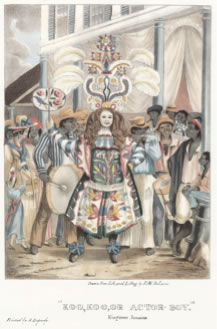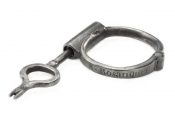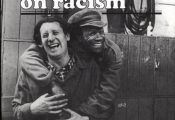Captioned “Koo, Koo, or Actor Boy,” this lithograph depicts an elaborately costumed and masked male dancer surrounded by on-lookers and musicians; he carries a whip and fan, the former used for clearing his path, the latter for cooling himself when his mask is lifted. The character is dressed to “mock” the European plantation owner in the form of a masquerade.
Belisario gives a detailed description of “John-Canoe” festivities and also speculates on the origin of the name. With respect to this illustration, he writes the “band consists of drums and fifes only, to which music the Actor stalks most majestically, oftentimes stopping to afford the by-standers a fair opportunity of gazing at him . . . . The foundation [of his headdress] is an old hat, affording the wearer the means of sustaining the superstructure, to which it is firmly attached, and composed of various coloured beads, bugles, spangles, pieces of looking-glass, tinsel, etc. attached to a pasteboard form trimmed round the edges with silver lace, surmounted with feathers. The garments are of muslin, silk, satin, and ribbons.” The image shown here, as well as others of “John-Canoes,” was drawn from life by Belisario in 1836.
John Canoe (Jonkonnu, JonKanoo) Dancers, Jamaica, 1838; Image Reference Belisario08, as shown on www.slaveryimages.org, sponsored by the Virginia Foundation for the Humanities and the University of Virginia Library.



